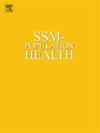Music in healthcare: Investigating music preferences for pain management across twenty countries
IF 3.6
2区 医学
Q1 PUBLIC, ENVIRONMENTAL & OCCUPATIONAL HEALTH
引用次数: 0
Abstract
Music is increasingly investigated in healthcare to manage pain, anxiety and stress. Previous studies have demonstrated that listening to (preferred) music is effective for pain relief, but rarely explore whether people are open to instrumentalizing music in healthcare. Therefore, this study investigates 1) to what extent people across twenty countries are willing to listen to music when experiencing pain in healthcare, and 2) which music genres they choose, in light of their national context, background characteristics, and overall music preferences. In addition, we investigate the universality of the so-called ‘Mozart effect’, which describes the belief that classical music is superior in healthcare, despite research suggesting that favorite music, irrespective of genre, is most effective. To answer these questions, we use data from the International Federation of the Phonographic Industry's international survey (2023), which includes twenty countries and 33,629 participants. In total, a large majority (86.5%) wants to listen to music when experiencing pain in healthcare. Although participants predominantly select music in line with their favorite music genres (73.1%), a smaller trend toward selecting classical music – in line with the ‘Mozart effect’ – is observed. Among those who prefer to listen to a music genre that they did not list as their favorite, classical music is predominantly chosen (43.3%). Furthermore, there are notable differences between national populations and across social groups in terms of preference for music when experiencing pain. These insights can be crucial for implementing music in healthcare worldwide, emphasizing the need for a culturally sensitive and personalized approach.
医疗保健中的音乐:调查20个国家疼痛管理的音乐偏好
越来越多的人在医疗保健中研究音乐,以缓解疼痛、焦虑和压力。先前的研究表明,听(喜欢的)音乐对缓解疼痛有效,但很少探讨人们是否愿意在医疗保健中使用音乐。因此,本研究调查了1)20个国家的人们在经历医疗疼痛时愿意听音乐的程度,以及2)根据他们的国家背景、背景特征和整体音乐偏好,他们选择哪种音乐类型。此外,我们调查了所谓的“莫扎特效应”的普遍性,它描述了人们认为古典音乐在医疗保健方面更优越,尽管研究表明,最喜欢的音乐,无论流派如何,都是最有效的。为了回答这些问题,我们使用了国际唱片业联合会的国际调查(2023年)的数据,该调查包括20个国家和33,629名参与者。总的来说,绝大多数(86.5%)的人在医疗过程中感到疼痛时想听音乐。尽管参与者主要选择与他们最喜欢的音乐类型相符的音乐(73.1%),但也观察到选择古典音乐的趋势较小——与“莫扎特效应”一致。在那些不喜欢听自己喜欢的音乐类型的人中,选择古典音乐的人最多(43.3%)。此外,在经历疼痛时,不同国家和不同社会群体对音乐的偏好也存在显著差异。这些见解对于在全球医疗保健中实施音乐至关重要,强调需要一种具有文化敏感性和个性化的方法。
本文章由计算机程序翻译,如有差异,请以英文原文为准。
求助全文
约1分钟内获得全文
求助全文
来源期刊

Ssm-Population Health
PUBLIC, ENVIRONMENTAL & OCCUPATIONAL HEALTH-
CiteScore
6.50
自引率
2.10%
发文量
298
审稿时长
101 days
期刊介绍:
SSM - Population Health. The new online only, open access, peer reviewed journal in all areas relating Social Science research to population health. SSM - Population Health shares the same Editors-in Chief and general approach to manuscripts as its sister journal, Social Science & Medicine. The journal takes a broad approach to the field especially welcoming interdisciplinary papers from across the Social Sciences and allied areas. SSM - Population Health offers an alternative outlet for work which might not be considered, or is classed as ''out of scope'' elsewhere, and prioritizes fast peer review and publication to the benefit of authors and readers. The journal welcomes all types of paper from traditional primary research articles, replication studies, short communications, methodological studies, instrument validation, opinion pieces, literature reviews, etc. SSM - Population Health also offers the opportunity to publish special issues or sections to reflect current interest and research in topical or developing areas. The journal fully supports authors wanting to present their research in an innovative fashion though the use of multimedia formats.
 求助内容:
求助内容: 应助结果提醒方式:
应助结果提醒方式:


